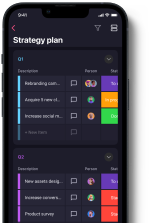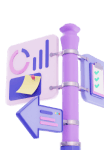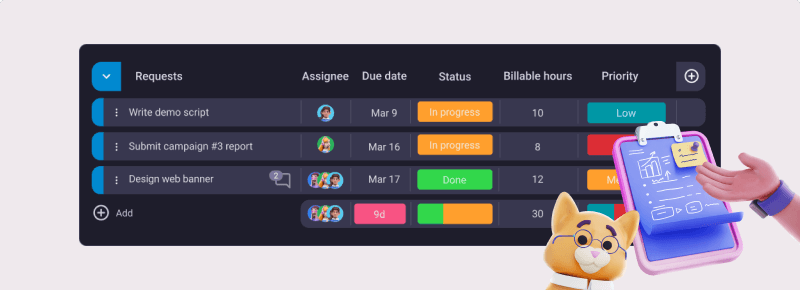Asana and monday.com are some of the most popular project management tools currently available.
I have tried both to see what they have to offer.
In this article, I am comparing their pricing, UX, features, support, and security.
My observations are based on the free versions of the apps.
Table of Contents
Asana vs monday.com: Main Features Comparison
The main differences between Asana and monday.com are that Asana is more user-friendly and offers a better free plan for teams, while monday.com comes with more collaboration features and better support.
Here’s a side-by-side overview of the apps’ main features:
| Feature | Asana | monday.com |
|---|---|---|
| Pricing | Free plan Paid plans start from $10.99 per user per month | Free plan Paid plans start from $9 per user per month |
| User interface | Clean, user-friendly | Clean, user-friendly |
| Task management | Well-organized | Well-organized |
| Team collaboration | Private messages Status updates Task comments @mentions | Co-editing documents Comments @mentions Brainstorming document |
| Progress tracking | Goals Milestones | Progress tracking column |
| Administration | Guest access Admin console | Guest access In Enterprise: – Audit log – Panic mode – Private workspaces |
| Integrations | 200+ | 200+ |
| Support | Help page Use cases Forum 24/7 customer support (on Enterprise plan) | Knowledge base Community page, Videos 24/7 customer support (on paid plans) |
| Security | Satisfactory | Satisfactory |
Asana offers more user seats for free, but monday.com’s paid plans are cheaper
Both tools have a free plan and several paid plans to choose from. They also both offer generous discounts for nonprofit organizations.
Asana has 4 pricing plans:
| Asana pricing plan | Yearly subscription | Monthly subscription |
|---|---|---|
| Basic | Free | Free |
| Premium | $10.99 per user per month | $13.49 |
| Business | $24.99 per user per month | $30.49 |
| Enterprise | Pricing by request | Pricing by request |
monday.com has 5 pricing options — a free plan and 4 paid plans:
| monday.com pricing plans | Yearly subscription | Monthly subscription |
|---|---|---|
| Free | Free | Free |
| Basic | $9 per seat per month | $12 per seat per month |
| Standard | $12 per seat per month | $14 per seat per month |
| Pro | $19 per seat per month | $24 per seat per month |
| Enterprise | Pricing by request | Pricing by request |
Asana’s Basic plan is free forever and includes:
- Unlimited tasks, projects, messages, and activity log,
- Collaboration with up to 15 colleagues,
- List, Board, and Calendar view,
- Mobile apps, and
- Assignee and due dates.
💡 Plaky Pro Tip
If you are looking for a free forever plan with unlimited users, you might want to look into an Asana alternative.
Unlike Asana, monday.com has a plan that is free forever, but only for up to 2 seats. So it is not really suited for teams but more for individuals who want to manage their work.
This free plan includes:
- 3 boards,
- Unlimited docs,
- Mobile apps,
- Activity log up to a week, and
- 200+ templates.
All the prices in monday.com’s paid plans apply to teams from 3 to 40 people, while bigger teams have to contact monday.com’s sales team for further pricing options.
Both monday.com and Asana offer discounts for nonprofits. Asana’s offer is simple — nonprofits are eligible for a 50% discount. monday.com’s offer is a bit more complex — there is a Nonprofit plan that includes 10 free seats and a 70% discount on other seats and an Enterprise plan for nonprofits that includes a 33% discount per user, but you need to buy at least 25 seats.
The downside of Asana is that they don’t offer refunds. But with the free version and a 30-day free trial, you have enough space to try out the app and see if it would fit you.
monday.com, on the other side, offers a 14-day free trial for the Pro plan for work management, monday sales CRM, and monday Dev. It also offers refunds for yearly subscriptions within 30 days of the purchase. But it doesn’t offer refunds for monthly subscriptions.
💡 Plaky Pro Tip
If you are looking for a more detailed description of monday.com and Asana pricing plans, read our guides:
Asana is more user-friendly
Asana has a clear interface that is easy to navigate. On the other hand, monday.com’s interface is recognizable for its vivid colors that help you easily spot the information you need.
Creating my first project in Asana was a fairly smooth process. I managed to set up a project, add sections and tasks, and fill in the fields in the tasks without any need for tutorials or additional materials.
The layout is simple but effective — white background with colorful fields, pictures, etc. There is a dark mode as well, but I preferred the light version.
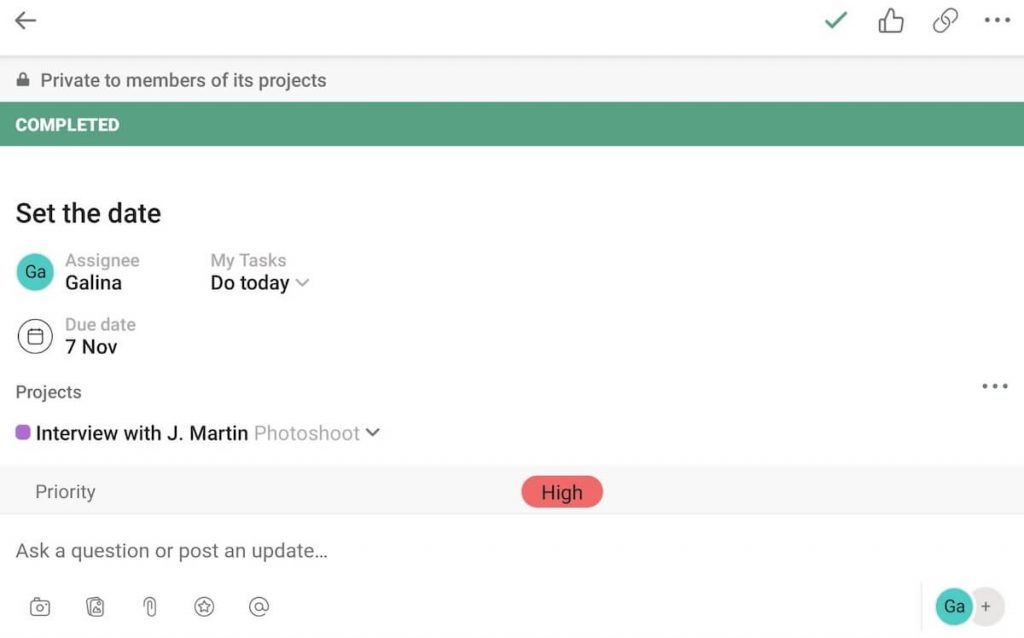
When you want to set up a board in monday.com, you can create it from scratch or choose a template. monday.com has a wide range of templates to help you get started, so even if you don’t have much experience with PM tools, you can manage monday.com without trouble.
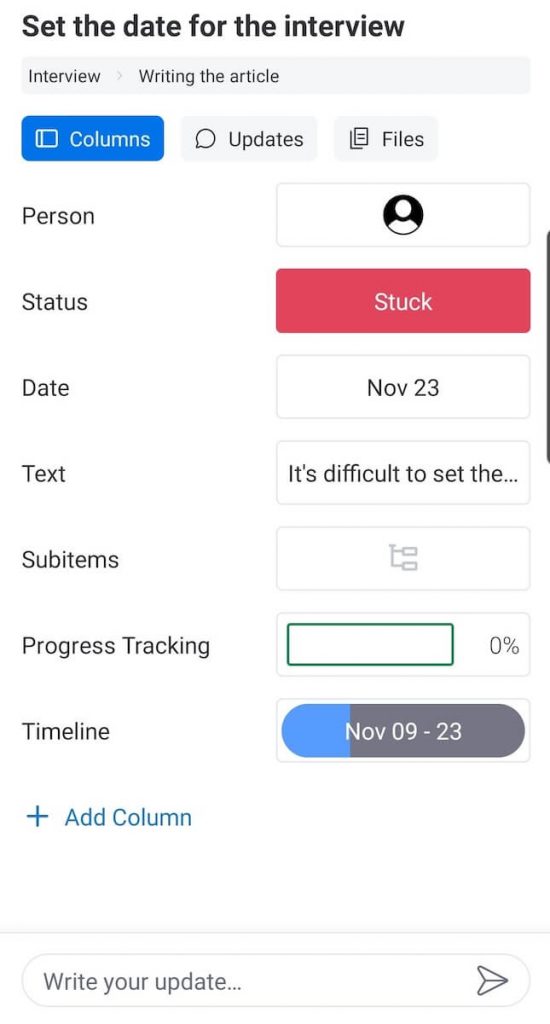
Both apps have a clean and colorful interface that isn’t difficult to master, but I found Asana to be more intuitive.
monday.com has more views, but Asana has better task definition
In Asana, you can choose from 7 views (List, Board, Gantt chart, Calendar, Files, Progress, and Timeline), but monday.com offers almost twice as many options.
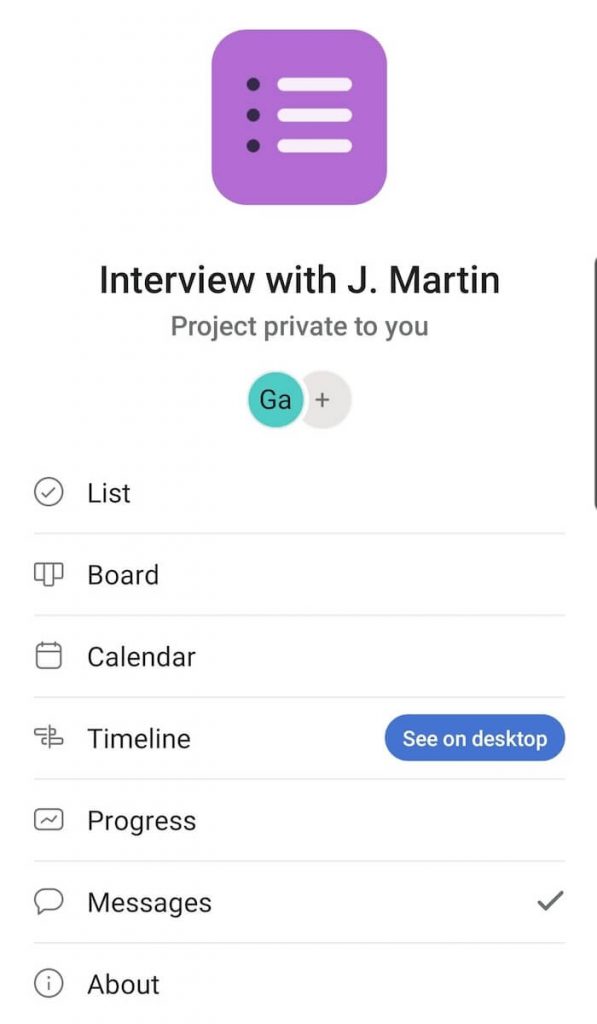
Some of the view options monday.com offers that you can’t find in Asana include:
- Chart view,
- Workload view,
- Cards view, and
- Map view.

Asana is highly customizable regarding task creation. You can create subtasks — and even subtasks of subtasks (up to 5 levels). I found this quite useful because it allowed me to divide more complex tasks without having to clutter the project’s task list.
On the other hand, while monday.com offers subitems, they’re not as elaborate and well-developed as in Asana.
A useful feature in monday.com is the Dashboard, which you can customize to fit your needs — you can add a budget tracker, timeline, overall progress chart, and more. In the Basic price plan, you can customize the Dashboard based on one board, while in the higher paying plans, you can combine from 5 to 50 boards on a dashboard to make your work more organized.
Asana offers a Dashboard feature as well. It’s available in all paid plans and supports various charts, such as Column chart, Line chart, Assignee chart, etc.
Both apps have a place for you to keep an eye on all your personal assignments. In monday.com, that’s My Work, and in Asana, My Tasks. In both apps, you can organize your tasks according to their due date (today, tomorrow, next week, etc.).
Although they essentially offer the same thing, monday.com’s My Work suited me better because the layout was well organized, and the distinction between the tasks due today, this week, or the next was more obvious than in Asana.
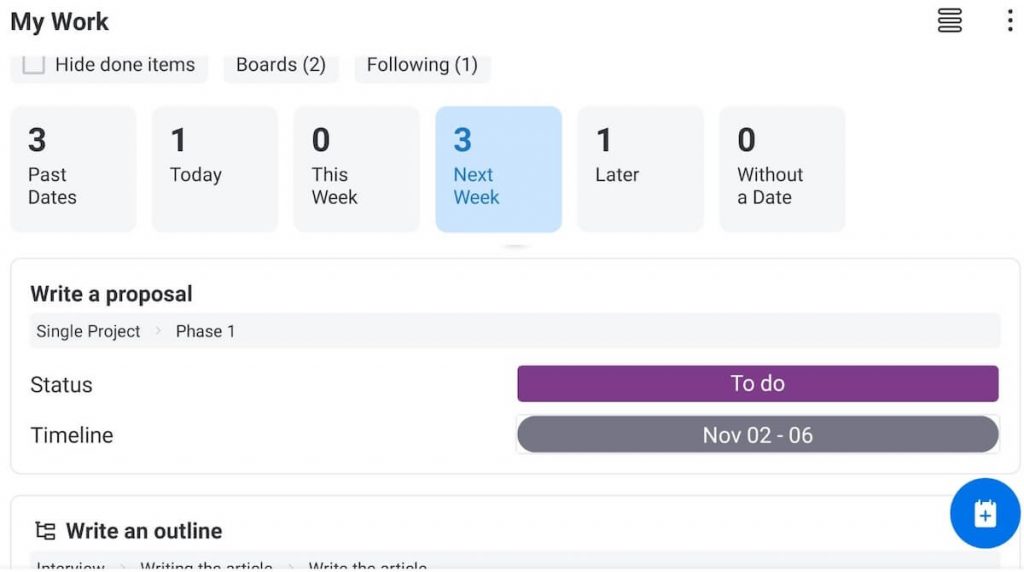
However, Asana offers custom sections you can add to organize your tasks in more detail.
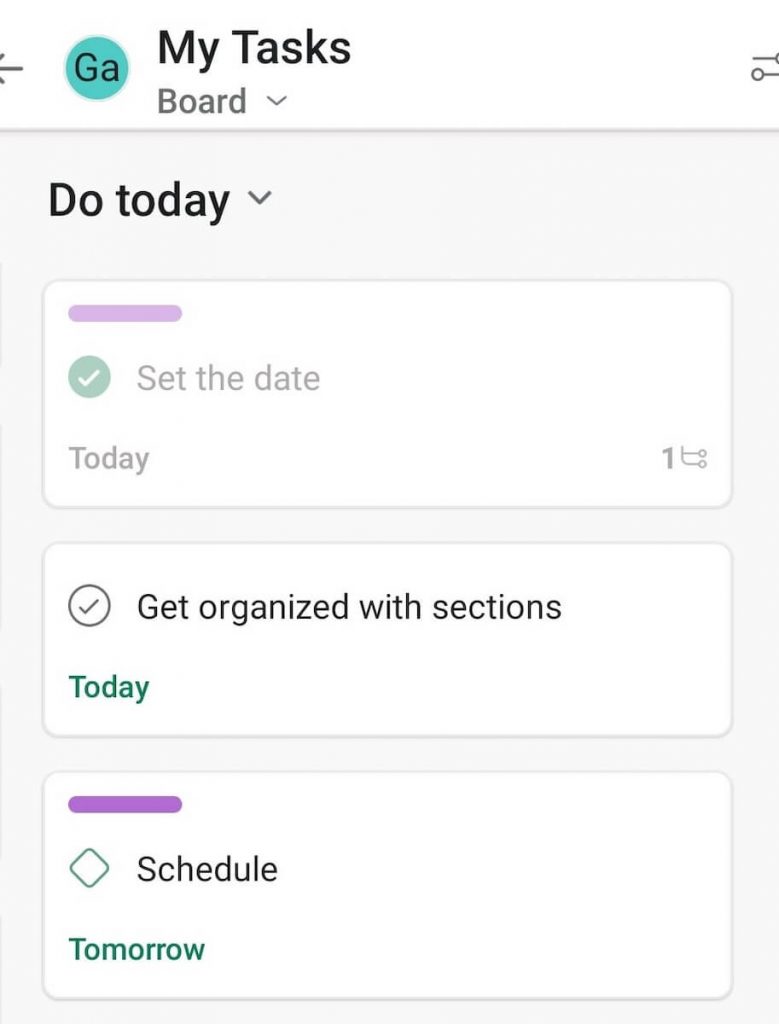
Another feature both Asana and monday.com excel at is the search option. They both offer an easy way for you to search through everything and find the task, project, board, doc, etc. you are looking for. You can also filter and save your searches.
Both Asana and monday.com have high-quality communication features, but monday.com offers more of them
While both Asana and monday.com have great messaging options integrated into their platform, monday.com’s offers more elaborate collaboration features with co-editing of docs and a template for collaborative brainstorming.
When I started working on a project in Asana, I discovered that there is a Messages section within a project, where you can share status updates, messages, and @mention a project member to help keep track of the project, which I found very useful.
You can also send private messages to a project team member or message an entire team.
You can collaborate with your teammates on the task level as well — leave messages, @mention a team member, or add followers to ensure everyone is in the loop.

Communication is made simple in monday.com. Just like in Asana, you can comment on tasks, @mention people or teams, and see all updates in the inbox section.
But what I like about monday.com is that the update section is clearly visible at the beginning of each task in the list view, so you can see right away which tasks have comments or updates added. Unfortunately, this is not the case in the Kanban view.
monday.com offers several ways for teams to collaborate within the platform. You can co-edit documents in real time, which is something Asana lacks.
You can also create a Brainstorming document from a template. Here, team members can share their ideas, suggestions, and thoughts, which can be a good way for the team to find a solution to any problems they encounter.
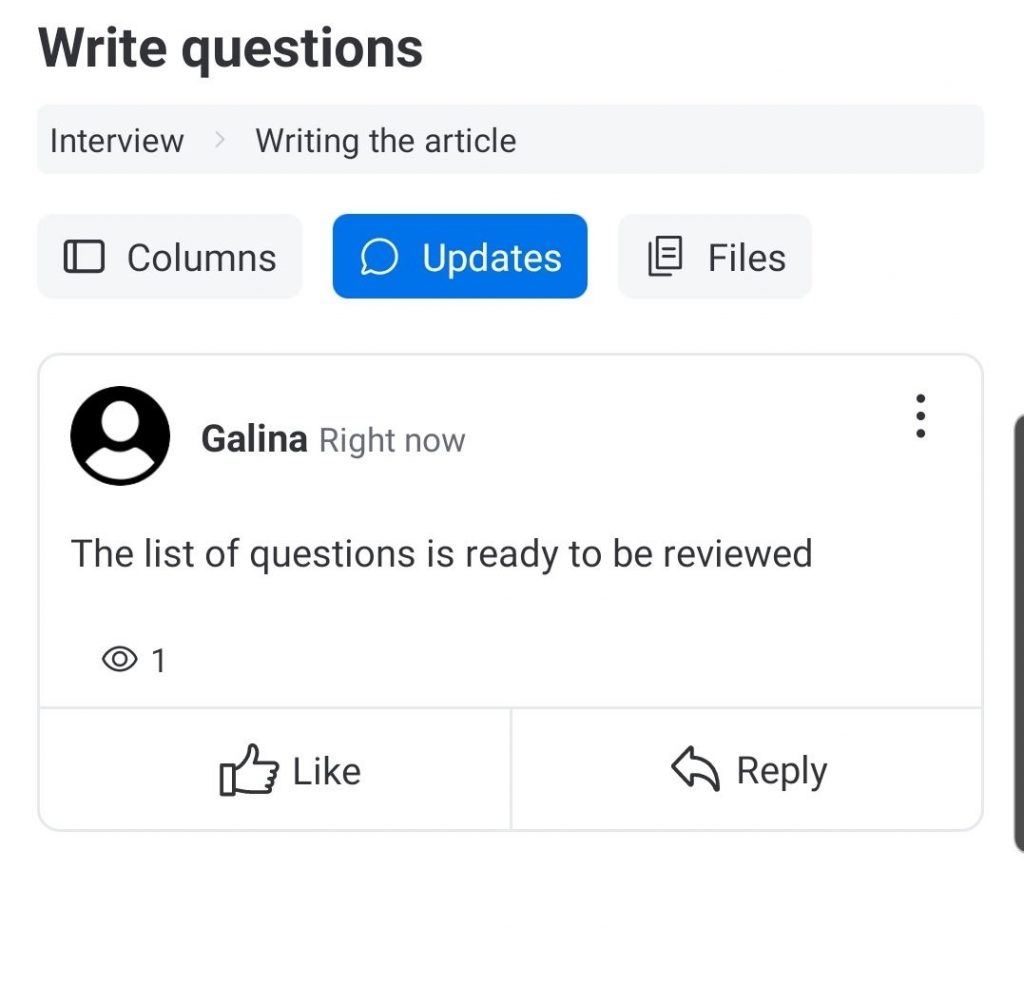
Both Asana and monday.com have a clear and simple way to track progress
Asana and monday.com offer different ways to track progress, but they’re both equally good.
Asana has a handy feature called Goals. You can create multiple goals and group them into:
- Company goals,
- Team goals, and
- Personal goals.
Once you’ve created a goal, you can also create subgoals that need to be accomplished in order to reach the main goal. At any given time, you can check the progress of each goal and subgoal to see if the project is progressing as desired.
monday.com doesn’t offer an elaborate way to track goals like Asana, but you can easily keep an eye on your progress via the progress tracking column.
In this column, you can keep an eye on all the status columns of each item to have a clear view of your tasks’ progress. This way, you can track the status of various tasks and see how close you are to completing a project in percentages.
I found the progress tracking column really practical since the visual representation makes it easy for me to have a clear picture of the overall progress.
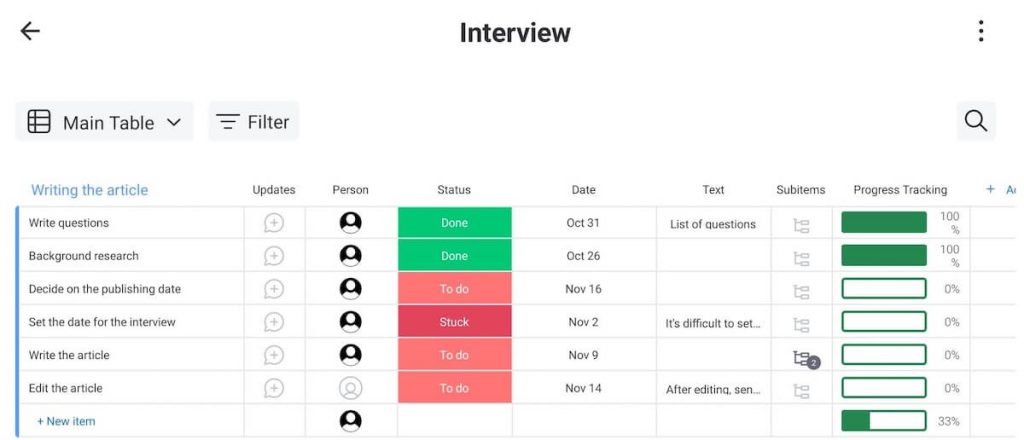
Although Asana doesn’t have a visual progress tracking option for tasks like monday.com, I liked the quick way to check your project’s progress — you just have to choose the Progress view, and it will show you how far the project got and if you have any overdue tasks.
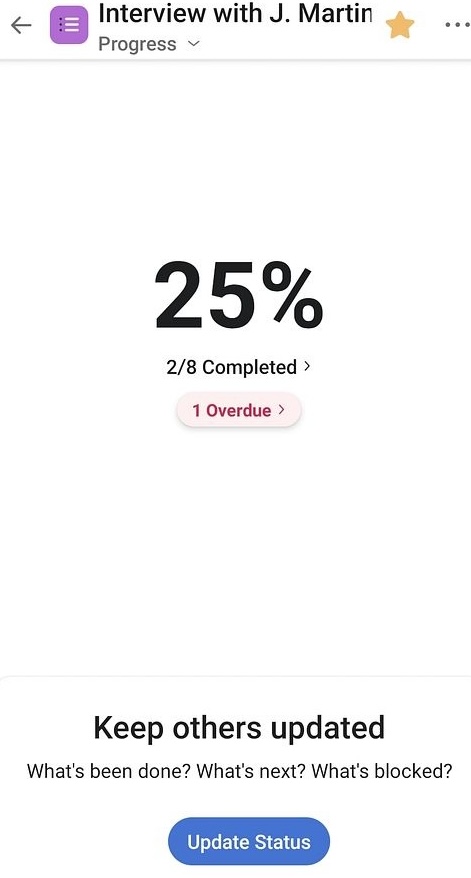
Another way to track progress is through project milestones. Asana classifies milestones as a type of task. They can be created from scratch, or you can simply transform an existing task into a milestone. It’s quite straightforward — it took me just 2 clicks to transform a task into a milestone.
You can create milestones in monday.com as well. You just need to click on a date on the Timeline and mark it as a milestone.
Asana offers more administrative features and more guest seats
Asana is more generous with admin features in the lower plans than monday.com. It offers an Admin console in Premium and higher paid plans. With the Admin console, you can:
- See your organization’s activity in Asana,
- Manage security settings and billing information, and
- Manage members and entire teams (invite or deactivate members, set privacy levels for teams, etc).
On the other hand, you need to choose the Enterprise plan to access most of the advanced administration features in monday.com.
If you pick the Enterprise plan, monday.com offers a variety of administration features, such as:
- Audit log — view who logged in, when, and from which IP address,
- Panic mode — lock your account in case of a security breach, and
- Private workspaces — control access to workspaces.
Asana is more generous with the guest access too — you can invite an unlimited number of guests in all paid plans. In contrast, monday.com offers 4 guests billed as 1 seat in the Standard plan and an unlimited number of guests only in higher plans.
Asana offers more integrations in the free plan
While both Asana and monday.com come with a decent number of integrations, Asana offers over 100 integrations in the free plan. In contrast, monday.com doesn’t offer integrations in the free and Basic plan.
Overall, Asana offers over 200 integrations, including Figma, Google Drive, GitHub, etc.
Some integrations, like Salesforce, Tableau, and Power BI, are available only in Business and Enterprise plans.
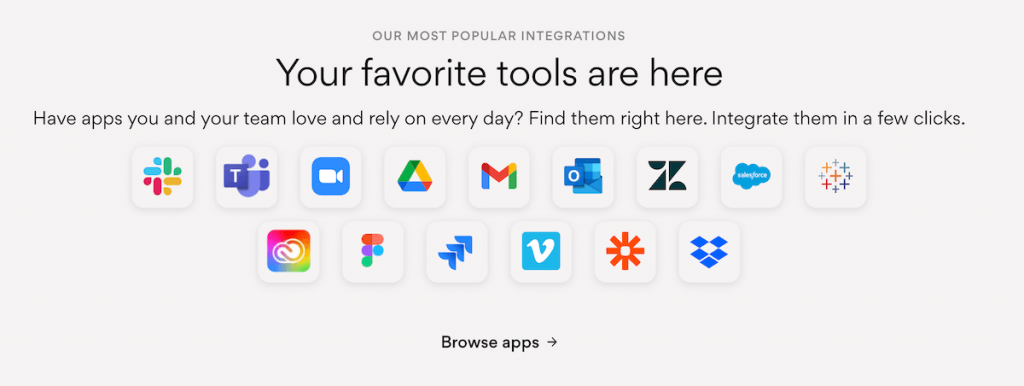
Same as Asana, monday.com has over 200 integrations, such as OneDrive, Zoom, Gmail, etc. But they are available only on a Standard plan or higher. Moreover, monday.com limits the use of integrations to 250 actions per month in the Standard plan, 25,000 in the Pro plan, and 250,000 in the Enterprise plan.
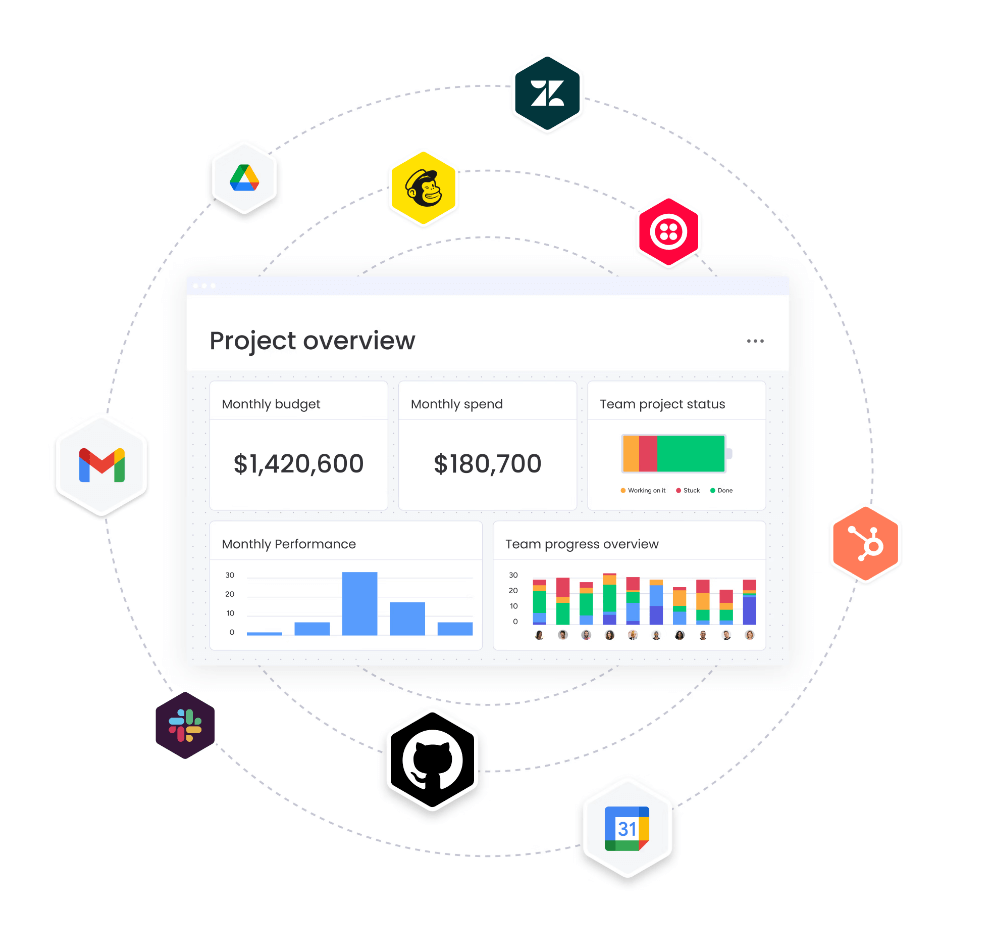
While both Asana and monday.com offer a decent number of integrations, Asana surpasses monday.com since it offers over 100 integrations in the free plan and doesn’t impose limitations on their use.
| Integrations | Asana | monday.com |
|---|---|---|
| Number of integrations | 200+ | 200+ |
| Overall impression | ⭐⭐⭐⭐⭐ | ⭐⭐⭐⭐ |
monday.com offers more options for contacting support
While monday.com offers several straightforward options for contacting support (email, chat, and call), the main way to reach Asana support is through the chat window on their support page.
When you state your problem, the Asana support bot will offer you articles from the help page that could help solve your problem. And if that’s not enough, you have the option to create a ticket for the support team.
While well-organized, it forces you to go through several steps before you get to create a ticket, which can be annoying. Moreover, it has no call option.
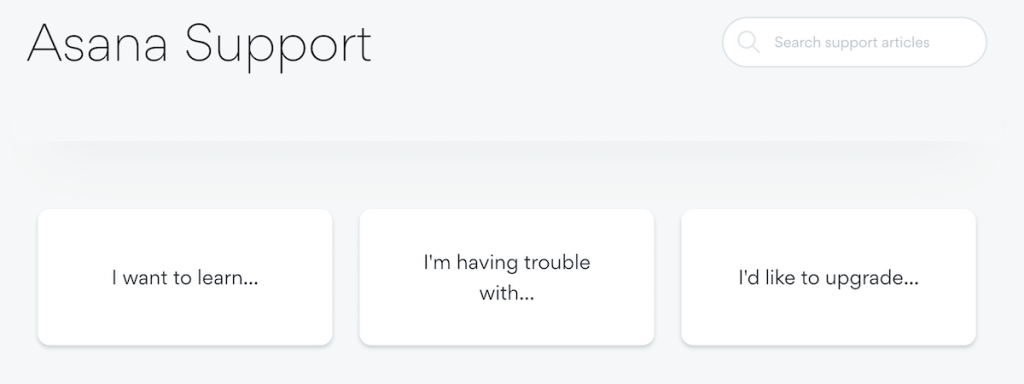
Additionally, all the paid plans in monday.com offer 24/7 customer support. Asana offers 24/7 customer support as well, but it is available only to Enterprise customers.
So, compared to Asana, monday.com offers a richer support system.
💡 Plaky Pro Tip
If you are looking for a tool that offers 24/7 support on the free plan, try this monday.com alternative.
Both tools offer rich resource libraries to help you find a solution for any problem you might have with the app or just to help you get started. While both are well-organized, I found it easier to navigate through Asana’s support page.
On Asana’s support page, you can find:
- Asana help — instructions for Asana features,
- Use cases — insight into how other teams use Asana,
- Developer’s guide — instructions on how to customize Asana and leverage data with Asana API,
- Asana forum — questions and discussions in 6 languages (English, Japanese, Spanish, French, German, and Portuguese), and
- Asana academy — training, courses, and webinars.
In contrast, monday.com offers:
- Knowledge base containing articles with instructions on how to best utilize monday.com,
- Videos with instructions, tutorials, and an overview of monday.com’s features, and
- Community page where you can see problems and questions other users had and how they solved them.
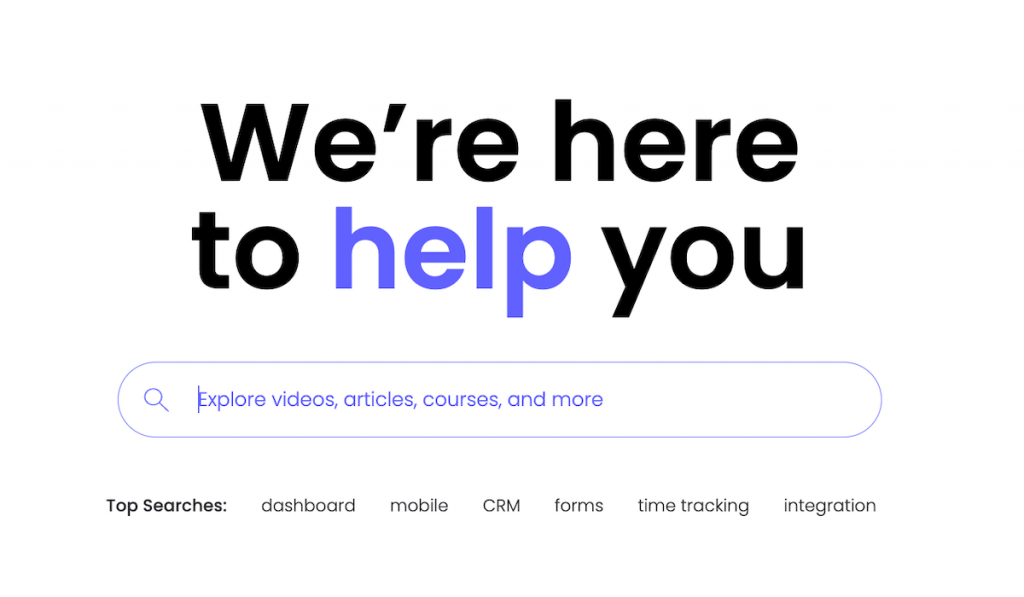
| Support | Asana | monday.com |
|---|---|---|
| Knowledge base/hub | Yes | Yes |
| 24/7 support | Only in Enterprise | In all paid plans |
| Overall impression | ⭐⭐⭐ | ⭐⭐⭐⭐ |
Both Asana and monday.com offer adequate security
Asana and monday.com both offer 2-factor authentication and have the relevant security certificates, such as:
- SOC 2 and 3,
- GDPR,
- ISO, and
- HIPAA.
Asana encrypts your data and manages data using Amazon’s relational database service (RDS), which allows it to recover from a database failure very quickly. It also allows you to encrypt data with your own key, using Enterprise Key Management (EKM).
On the other hand, monday.com encrypts data in transit using TLS and at rest using AES-256 (Advanced Encryption Standard) or better.
To ensure you don’t lose your data, monday.com backs up user data every 5 minutes and encrypts all backups. They also have a disaster recovery plan they test twice a year.
| Security | Asana | monday.com |
|---|---|---|
| Two-factor authentication | Yes | Yes |
| Data encryption | Yes | Yes |
| Relevant Certifications | Yes | Yes |
| Overall impression | ⭐⭐⭐⭐⭐ | ⭐⭐⭐⭐⭐ |
Asana vs monday.com: Which should you use? And when?
Use Asana if:
- You have a small team (up to 15) and a limited budget,
- You work with outside contractors (an unlimited number of guests is great for this).
Use monday.com if:
- You need to collaborate on docs and brainstorm with your team, or
- You don’t want to make a project from scratch and need a wide range of templates.
Looking for an Asana or monday.com alternative? Try Plaky
If you haven’t found what you’re looking for in Asana or monday.com, you should consider Plaky.
Like Asana, its free plan comes with unlimited tasks and projects — but it also allows you to invite as many members as you like to your space (or multiple spaces).
Plaky’s strong free plan also makes it a good alternative to monday.com, which offers a very limited set of features and only 2 user seats for free.
In comparison, Plaky’s free plan offers:
- Unlimited users,
- Unlimited boards, spaces, and items,
- Comments and @mentions,
- Sort and filter options,
- Google and Apple SSO, and more.
Unlike both apps, Plaky also offers 24/7 support with 1h average response time in the free plan.
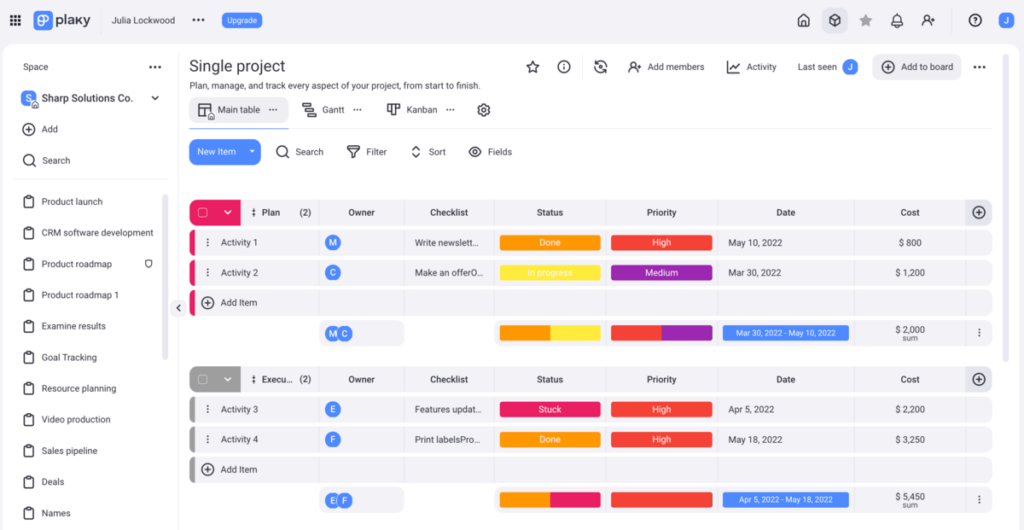
Aside from a free plan, Plaky has 2 paid plans:
- Pro plan — $3.99 per user per month, and
- Enterprise plan — $8.99 per user per month.
At a highly affordable price, you get a bunch of additional features, such as bulk actions, board and task templates, private boards, advanced permissions, and more.



